HONDA CIVIC COUPE 1998 Owner's Guide
Manufacturer: HONDA, Model Year: 1998, Model line: CIVIC COUPE, Model: HONDA CIVIC COUPE 1998Pages: 251, PDF Size: 2.04 MB
Page 31 of 251
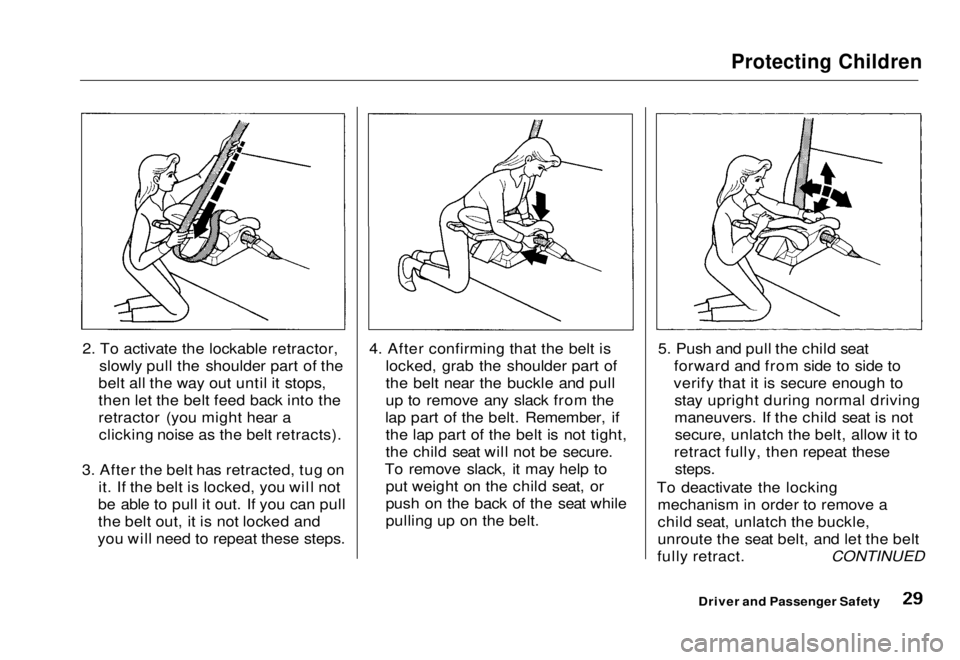
Protecting Children
2. To activate the lockable retractor, slowly pull the shoulder part of the
belt all the way out until it stops,
then let the belt feed back into the
retractor (you might hear a clicking noise as the belt retracts).
3. After the belt has retracted, tug on it. If the belt is locked, you will not
be able to pull it out. If you can pull
the belt out, it is not locked and
you will need to repeat these steps. 4. After confirming that the belt is
locked, grab the shoulder part of
the belt near the buckle and pull
up to remove any slack from the
lap part of the belt. Remember, if the lap part of the belt is not tight,
the child seat will not be secure.
To remove slack, it may help to put weight on the child seat, or
push on the back of the seat while
pulling up on the belt. 5. Push and pull the child seat
forward and from side to side to
verify that it is secure enough to stay upright during normal driving
maneuvers. If the child seat is notsecure, unlatch the belt, allow it to
retract fully, then repeat these
steps.
To deactivate the locking mechanism in order to remove a
child seat, unlatch the buckle,
unroute the seat belt, and let the belt
fully retract. CONTINUED
Driver and Passenger SafetyMain Menu Table of Contents s t
Page 32 of 251
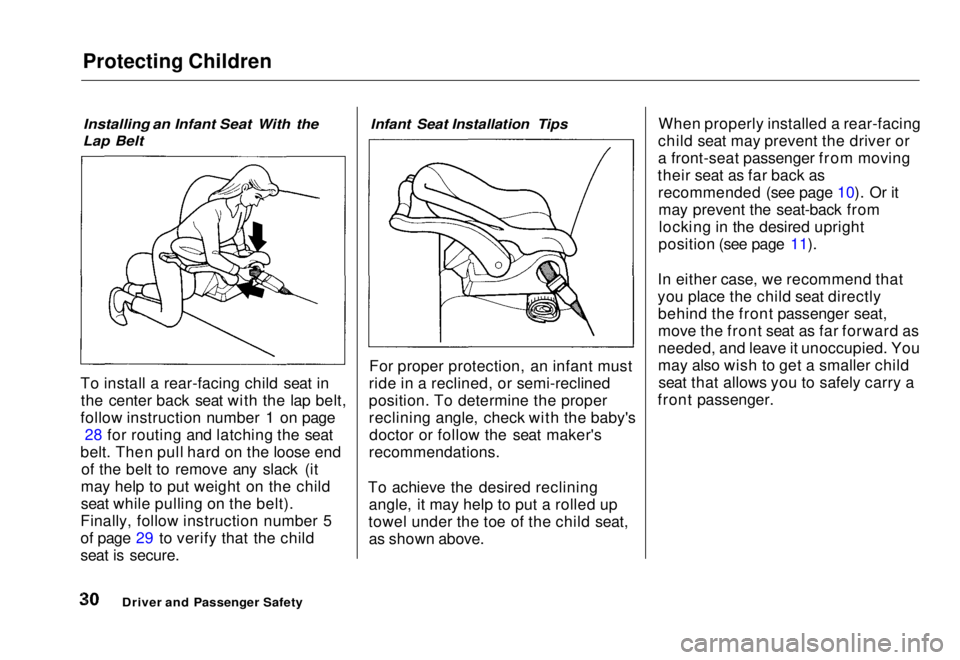
Protecting Children
Installing an Infant Seat With the
Lap Belt
To install a rear-facing child seat in the center back seat with the lap belt,
follow instruction number 1 on page 28 for routing and latching the seat
belt. Then pull hard on the loose end of the belt to remove any slack (it
may help to put weight on the child
seat while pulling on the belt).
Finally, follow instruction number 5
of page 29 to verify that the child
seat is secure.
Infant Seat Installation Tips
For proper protection, an infant must
ride in a reclined, or semi-reclined
position. To determine the proper
reclining angle, check with the baby's doctor or follow the seat maker's
recommendations.
To achieve the desired reclining angle, it may help to put a rolled up
towel under the toe of the child seat, as shown above. When properly installed a rear-facing
child seat may prevent the driver or
a front-seat passenger from moving
their seat as far back as recommended (see page 10). Or itmay prevent the seat-back fromlocking in the desired upright
position (see page 11).
In either case, we recommend that
you place the child seat directly behind the front passenger seat,
move the front seat as far forward as
needed, and leave it unoccupied. You
may also wish to get a smaller childseat that allows you to safely carry a
front passenger.
Driver and Passenger SafetyMain Menu Table of Contents s t
Page 33 of 251
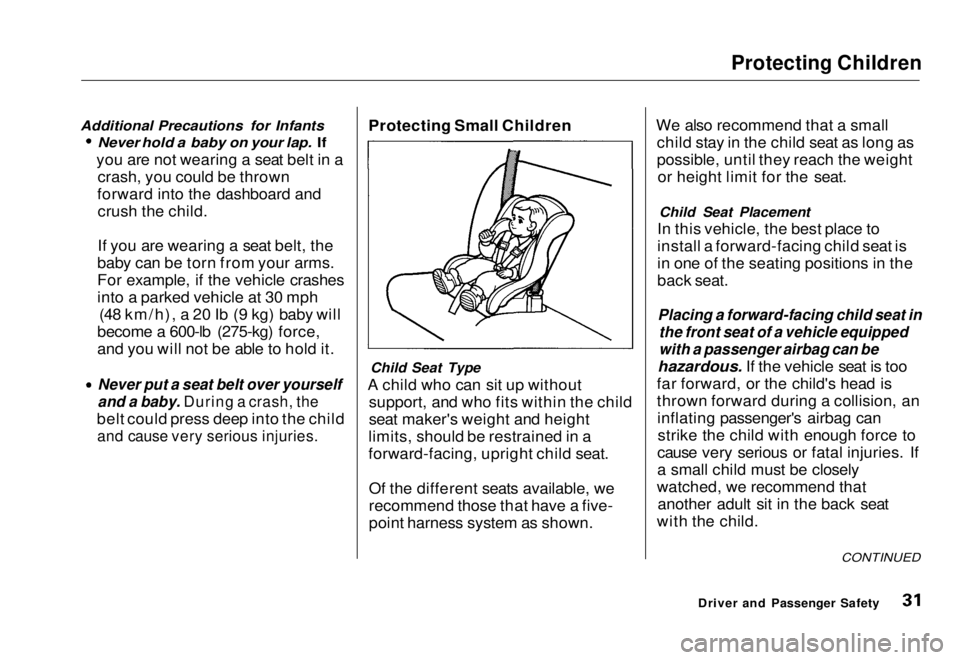
Protecting Children
Additional Precautions for Infants
Never hold a baby on your lap. If
you are not wearing a seat belt in a crash, you could be thrown
forward into the dashboard and crush the child.
If you are wearing a seat belt, the
baby can be torn from your arms.
For example, if the vehicle crashes
into a parked vehicle at 30 mph (48 km/h), a 20 Ib (9 kg) baby will
become a 600-lb (275-kg) force,
and you will not be able to hold it.
Never put a seat belt over yourself
and a baby. During a crash, the
belt could press deep into the child
and cause very serious injuries.
Protecting Small Children
Child Seat Type
A child who can sit up without support, and who fits within the child
seat maker's weight and height
limits, should be restrained in a
forward-facing, upright child seat.
Of the different seats available, we
recommend those that have a five-
point harness system as shown. We also recommend that a small
child stay in the child seat as long as
possible, until they reach the weightor height limit for the seat.
Child Seat Placement
In this vehicle, the best place to
install a forward-facing child seat is
in one of the seating positions in the
back seat.
Placing a forward-facing child seat in the front seat of a vehicle equipped
with a passenger airbag can be
hazardous. If the vehicle seat is too
far forward, or the child's head is
thrown forward during a collision, an inflating passenger's airbag canstrike the child with enough force to
cause very serious or fatal injuries. If
a small child must be closely
watched, we recommend that another adult sit in the back seat
with the child.
Driver and Passenger Safety
CONTINUEDMain Menu Table of Contents s t
Page 34 of 251

Protecting Children
If it is necessary to put a forward-
facing child seat in the front, move
the vehicle seat as far to the rear as possible, be sure the child seat is
firmly secured to the car, and that
the child is properly strapped in the
seat.
Installing a Child Seat With a Lap/
Shoulder Belt
The lap/shoulder belts in the back
and front passenger seating positions
have a locking mechanism that must be activated to secure a child seat.
The following pages provide instructions on how to secure a
forward-facing child seat with this
type of seat belt.
See page 34 for how to secure a
forward-facing child seat in the center back seat with the lap belt. 1. With the child seat in the desired
seating position, route the belt
through the child seat according
to the seat maker's instructions, then insert the latch plate into the
buckle.
Driver and Passenger Safety
Improperly placing a forward-
facing child seat in the front seat can result in serious injury
or death if the airbags inflate.
If you must place a forward-
facing child seat in front, move
the vehicle seat as far back as possible and properly restrain
the child.Main Menu Table of Contents s t
Page 35 of 251

Protecting Children
2. To activate the lockable retractor, slowly pull the shoulder part of the
belt all the way out until it stops,
then let the belt feed back into the
retractor (you might hear a clicking noise as the belt retracts).
3. After the belt has retracted, tug on it. If the belt is locked, you will not
be able to pull it out. If you can pull the belt out, it is not locked and
you will need to repeat these steps.
4. After confirming that the belt is
locked, grab the shoulder part of
the belt near the buckle and pull
up to remove any slack from the
lap part of the belt. Remember, if
the lap part of the belt is not tight,
the child seat will not be secure. It
may help to put weight on the
child seat, or push on the back of
the seat while pulling up on the
belt.
5. Push and pull the child seat
forward and from side to side to
verify that it is secure enough tostay upright during normal driving
maneuvers. If the child seat is not secure, unlatch the belt, allow it to
retract fully, then repeat these
steps.
CONTINUED
Driver and Passenger SafetyMain Menu Table of Contents s t
Page 36 of 251

Protecting Children
To deactivate the locking mechanism in order to remove a
child seat, unlatch the buckle,
unroute the seat belt, and let the belt
fully retract.
Installing a Child Seat With the Lap
Belt
To install a forward-facing child seat in the center back seat with the lap
belt, follow instruction number 1 on
page 32 for routing and latching the seat belt. Then pull hard on the loose
end of the belt to remove any slack (it may help to put weight on the
child seat while pulling on the belt).
Finally, follow instruction number 5
on page 33 to verify that the child
seat is secure.
Additional Precautions for Small
Children
Never
hold a small ch \
ild on your
lap. If you are not wearing a seat
belt in a crash, you could be thrown forward into thedashboard and crush the child.
If you are wearing a seat belt, the
child can be torn from your arms during a crash. For example, if the
vehicle crashes into a parked
vehicle at 30 mph (48 km/h), a 30 Ib (14 kg) child will become a
900-lb (410-kg) force, and you will
not be able to hold it.
Never put a seat belt over yourself
and a child. During a crash, the
belt could press deep into the child and cause very serious injuries.
Driver and Passenger SafetyMain Menu Table of Contents s t
Page 37 of 251
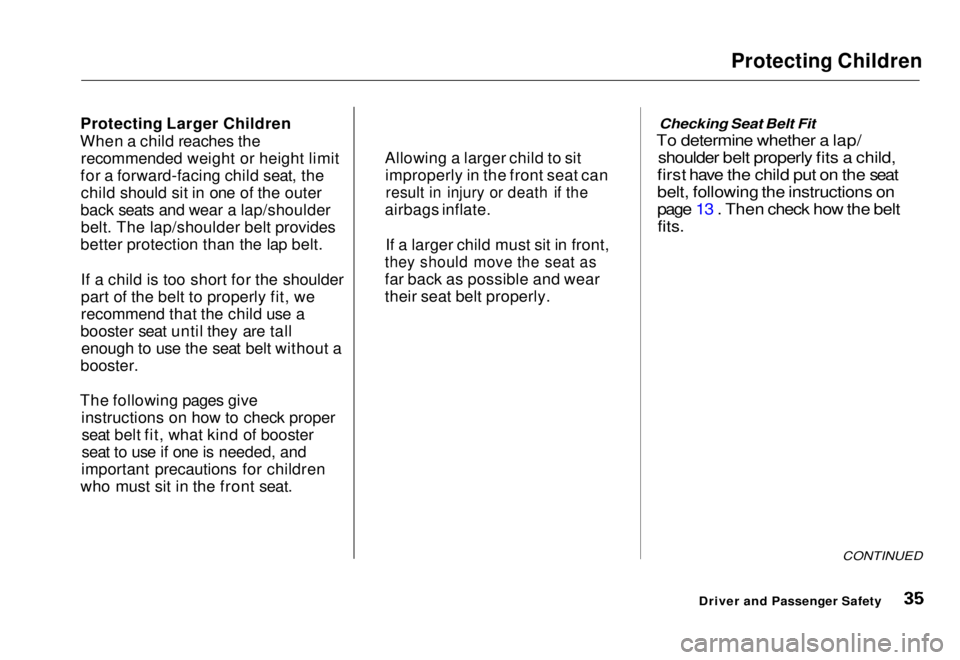
Protecting Children
Protecting Larger Children
When a child reaches the recommended weight or height limit
for a forward-facing child seat, the child should sit in one of the outer
back seats and wear a lap/shoulder belt. The lap/shoulder belt provides
better protection than the lap belt.
If a child is too short for the shoulder
part of the belt to properly fit, we
recommend that the child use a
booster seat until they are tall enough to use the seat belt without a
booster.
The following pages give instructions on how to check properseat belt fit, what kind of booster
seat to use if one is needed, and
important precautions for children
who must sit in the front seat.
Checking Seat Belt Fit
To determine whether a lap/ shoulder belt properly fits a child,
first have the child put on the seat
belt, following the instructions on
page 13 . Then check how the belt
fits.
CONTINUED
Driver and Passenger Safety
Allowing a larger child to sit
improperly in the front seat can
result in injury or death if the
airbags inflate.
If a larger child must sit in front,
they should move the seat as
far back as possible and wear
their seat belt properly.Main Menu Table of Contents s t
Page 38 of 251
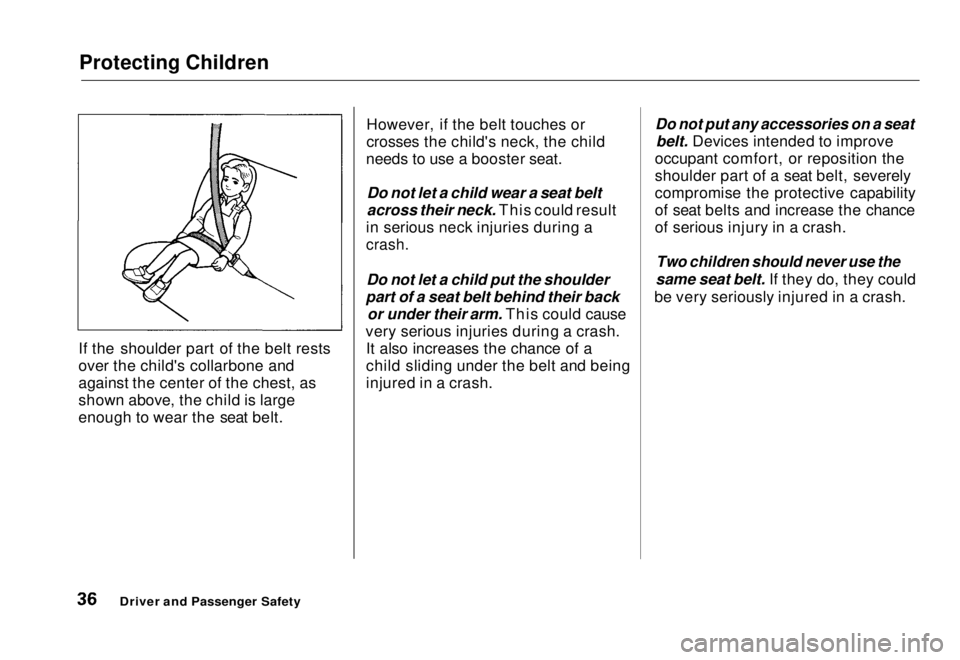
Protecting Children
If the shoulder part of the belt rests
over the child's collarbone and
against the center of the chest, as
shown above, the child is large
enough to wear the seat belt. However, if the belt touches or
crosses the child's neck, the child
needs to use a booster seat.
Do not let a child wear a seat belt
across their neck. This could result
in serious neck injuries during a
crash.
Do not let a child put the shoulder
part of a seat belt behind their back or under their arm. This could cause
very serious injuries during a crash. It also increases the chance of a
child sliding under the belt and being
injured in a crash.
Do not put any accessories on a seat
belt. Devices intended to improve
occupant comfort, or reposition the
shoulder part of a seat belt, severely
compromise the protective capability
of seat belts and increase the chance
of serious injury in a crash.
Two children should never use the
same seat belt. If they do, they could
be very seriously injured in a crash.
Driver and Passenger SafetyMain Menu Table of Contents s t
Page 39 of 251
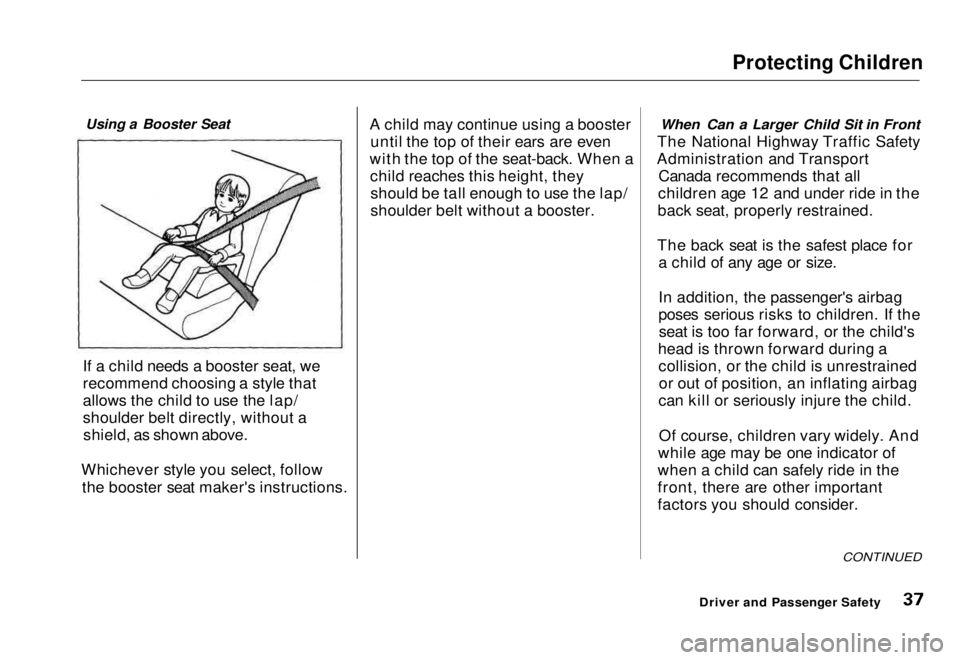
Protecting Children
Using a Booster Seat
If a child needs a booster seat, we
recommend choosing a style that
allows the child to use the lap/
shoulder belt directly, without a shield, as shown above.
Whichever style you select, follow the booster seat maker's instructions. A child may continue using a booster
until the top of their ears are even
with the top of the seat-back. When a child reaches this height, theyshould be tall enough to use the lap/
shoulder belt without a booster.
When Can a Larger Child Sit in Front
The National Highway Traffic Safety
Administration and Transport Canada recommends that all
children age 12 and under ride in the
back seat, properly restrained.
The back seat is the safest place for a child of any age or size.
In addition, the passenger's airbag
poses serious risks to children. If theseat is too far forward, or the child's
head is thrown forward during a collision, or the child is unrestrainedor out of position, an inflating airbag
can kill or seriously injure the child.
Of course, children vary widely. And
while age may be one indicator of
when a child can safely ride in the
front, there are other important
factors you should consider.
CONTINUED
Driver and Passenger SafetyMain Menu Table of Contents s t
Page 40 of 251
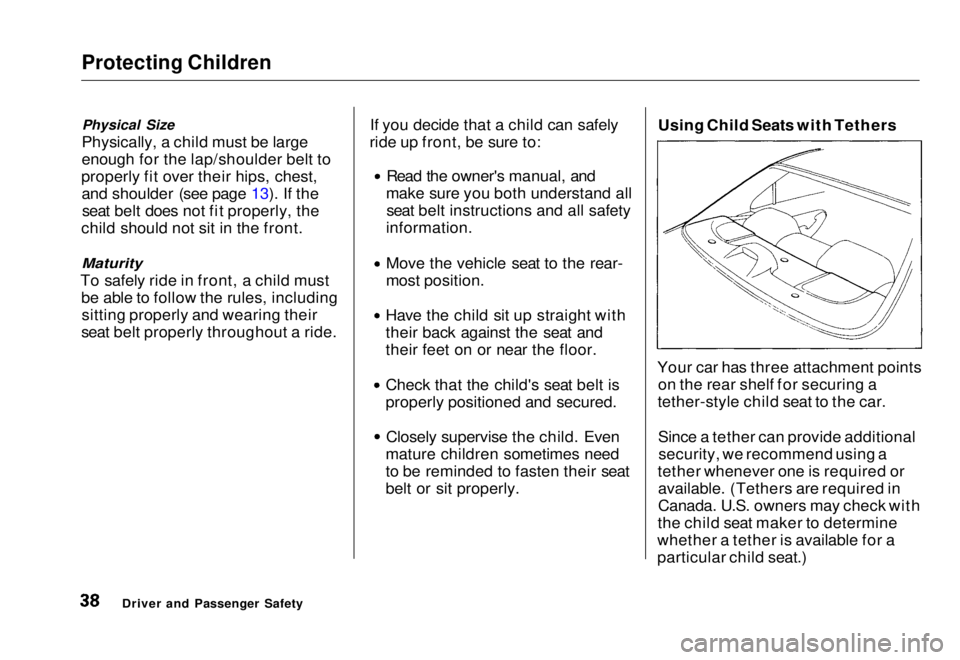
Protecting Children
Physical Size
Physically, a child must be large
enough for the lap/shoulder belt to
properly fit over their hips, chest, and shoulder (see page 13). If theseat belt does not fit properly, the
child should not sit in the front.
Maturity
To safely ride in front, a child must be able to follow the rules, includingsitting properly and wearing their
seat belt properly throughout a ride. If you decide that a child can safely
ride up front, be sure to: Read the owner's manual, and
make sure you both understand all seat belt instructions and all safety
information. Move the vehicle seat to the rear-
most position.
Have the child sit up straight with
their back against the seat and
their feet on or near the floor.
Check that the child's seat belt is
properly positioned and secured.
Closely supervise the child. Even
mature children sometimes need
to be reminded to fasten their seat
belt or sit properly. Using Child Seats with Tethers
Your car has three attachment points on the rear shelf for securing a
tether-style child seat to the car.
Since a tether can provide additionalsecurity, we recommend using a
tether whenever one is required or available. (Tethers are required in
Canada. U.S. owners may check with
the child seat maker to determine
whether a tether is available for a
particular child seat.)
Driver and Passenger SafetyMain Menu Table of Contents s t